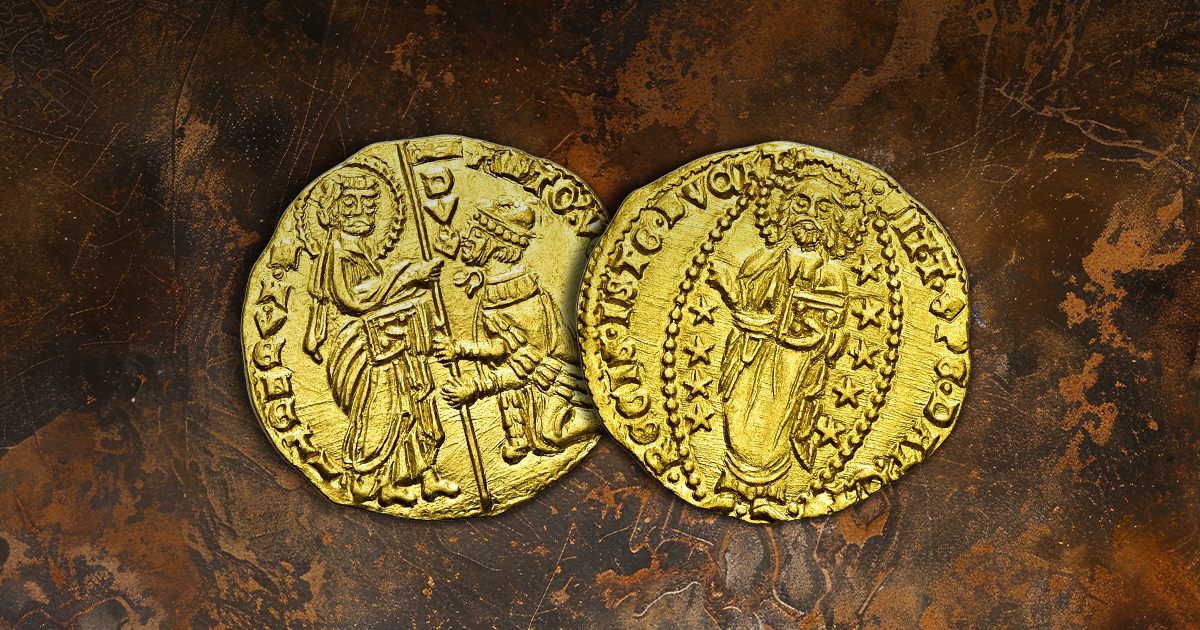
The ducat is a historic gold coin that played a pivotal role in European culture and commerce from its inception in the Middle Ages through the 20th century. It was primarily issued in gold and is collected today for its gold content, historical significance, and aesthetic appeal.
How Much Gold is in a Gold Ducat?
Although the gold ducat was issued by many nations over 7 centuries, it had a fairly consistent 3.4-3.49 grams of 98.6% gold. Its gold content was set following the weight of Florentine florin, which had 54 grains of gold. As a relatively modern coin, the ducat was issued in denominations from the universal 1 ducat to the Polish 100 ducats.
How Many Nations Issued Gold Ducats?
The official count varies due to changes in government structures, but it is generally accepted that at least ten nations produced gold ducats.
- Austria
- Czechoslovakia
- Dutch Republic/ The Netherlands
- Germany/German States
- Hungary
- Poland
- Romania
- Russia
- Sweden
- Venice/Italy
History and Origin of the Ducat
The word ducat comes from the Medieval Latin ducalis, which means “related to a duke” or “related to a duchy,” and through its use, it initially meant “duke’s coin.” Ducats were first produced in the late 13th century and quickly found use as a trade coin throughout Europe and beyond due to their high purity and consistent weight. Early ducats were influenced by Byzantine and Arabic designs and many depicted Jesus with Latin inscriptions.
The First Ducat
The first ducat was issued in silver billon in 1140 by Roger II, the Norman Count, and later King of Sicily, for his duchy of Apulia in southeastern Italy. It was a scyphate, or concave coin, shaped like a Byzantine trachea. On its obverse, it depicted Jesus with the Latin words Sit tibi, Christe, datus, quem tur egis iste ducatus or “Oh Christ, let this duchy, which you rule, be dedicated to you.” The reverse featured Roger II stylized as a Byzantine emperor with his eldest son, Duke Roger III, dressed for battle.
The First Gold Ducat
The gold ducat was introduced to Venice in 1284 by Doge Giovanni Dandolo and soon became one of the principal coins in European commerce and trade. The design remained consistent, featuring the Doge of Venice before Saint Mark on its obverse and Christ standing in a field of stars on the reverse.
The Ducat in the 14th and 15th Centuries
While Venice slowly expanded areas in which it traded, its ducat traveled with it and earned widespread acceptance. The Venetian ducat inspired the Ottomans, the Mamluks, and the Knights of Saint Jogn in the Levant. In Western Europe, the ducat gained popularity amid the debasement of other coins like the Rhenish florin. By the 15th century, it had become the preferred currency for international traders, and versions of the ducat were minted across Europe in nations like Hungary and Spain.
The Ducat in the 16th to 18th Centuries
The adoption of the ducat grew in the 16th century, and several nations began using it as the model for their currencies. Under Emperor Maximilian I, the Holy Roman Empire started producing gold ducats in Austria in 1511. The first Netherlands gold ducats were minted shortly after the Netherlands gained independence from Spain in 1586, and Dutch gold ducats became influential because of widespread international trade. The ducat spread as far as Russia and Poland, where it was copied and adapted to the local needs.
The Silver Ducaton and Decline of the Ducat
In addition to the gold ducat, silver versions known as ducatons were minted in Italy and other nations. These large silver coins were first issued in the mid-16th century and used for trade. With the introduction of newly mined American gold in the 17th century, the Spanish dollar began to overshadow the ducat. By the 19th century, the ducat was replaced as a standard currency altogether after the formation of the Latin Monetary Union and the Vienna Monetary Treaty.
20th Century Ducats and Their Role During World War I
Onset of World War I
As Europe entered the 20th century, nations like Austria-Hungary were still minting the ducat. The onset of World War I brought significant changes to the monetary landscape of Europe, straining national economies, inflation, and the need for hard currency.
During World War I
The Austrian government continued to mint gold ducats during World War I, although the last official mintage occurred in 1915. These coins were seen as a symbol of stability in a rapidly destabilizing world. Their gold content made them a preferred choice for those looking to preserve their wealth. The war also posed disruptions in trade, and the ducat’s circulation began to decline as wartime economies struggled to maintain the gold standard.
As the war raged, many European countries abandoned the gold standard to fund their military expenses through fiat currency and debt. Moving away from gold reduced the practical use of gold coins like the ducat in everyday transactions, relegating them more to the realm of collectors and investors.
After World War I
In the antebellum period, Austria, which had been the primary issuer of the ducat, faced significant economic challenges. After the Austro-Hungarian Empire crumbled, new nations emerged in the altered political landscape. Despite these changes, the Austrian Mint continued to produce ducats as bullion coins for collectors and investors rather than as currency for trade.
The Ducat’s Influence and Legacy
Despite its decline in circulation, the ducat was continually produced in Austria until 1938. The restrikes of the Austrian 1915 1 and 4 gold ducats are popular among collectors today, and the Venetian gold ducat remains emblematic of European numismatic history. Its widespread use and nearly countless imitations underscore its importance as one of the most influential coins in history.




